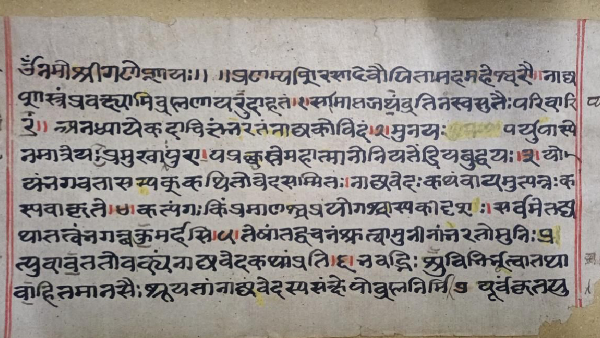UNESCO Recognises Bhagavad Gita and Natyashastra
Recently, the manuscripts of the Bhagavad Gita and Bharata’s Natyashastra were added to UNESCO’s Memory of the World Register. This recognition marks their significance in preserving cultural heritage.
UNESCO’s Memory of the World Programme
UNESCO initiated the Memory of the World Programme in 1992. Its goal is to safeguard documentary heritage globally. This includes manuscripts, oral traditions, and archival materials of outstanding universal value. The programme aims to prevent collective amnesia and ensure accessibility to documents. The Memory of the World Register is updated biennially, featuring entries from various countries.
Significance of the Bhagavad Gita
The Bhagavad Gita is a 700-verse scripture embedded in the Mahabharata. It is a dialogue between Arjuna and Krishna, addressing moral dilemmas before a great war. The Gita synthesises various philosophical traditions, including Vedic, Buddhist, and Jain thoughts. Its teachings on duty, righteousness, and devotion have influenced countless readers and thinkers globally.
Importance of Natyashastra
The Natyashastra is an ancient treatise on performing arts, attributed to sage Bharata. It consists of 36,000 verses detailing the principles of drama, performance, and aesthetics. The concept of ‘rasa’ is central to its teachings, emphasising the emotional experience of art. This text has deeply shaped Indian theatre, dance, and music, serving as a foundational guide for artists.
India’s Contributions to the Register
With the recent additions, India now has 14 entries in the Memory of the World Register. These include:
- IAS Tamil Medical Manuscript Collection (1997)
- First Indian entry in UNESCO’s World Register.
- 564 Tamil medical texts on palm leaves.
- Stored at the Institute of Asian Studies, Chennai.
- Contains Siddha and Ayurveda knowledge—how to make medicines from herbs.
- Saiva Manuscripts (2005)
- Ancient texts related to Shaivism—Agamas, hymns, local temple legends.
- Includes Siddha medical knowledge.
- Date back to 6th century CE till colonial period.
- Preserved in Pondicherry by French institutes.
- Rigveda (2007)
- Oldest known Veda and world’s first literary work.
- Only one version exists today—Shaakala shakha.
- Contains 10,552 mantras in 10 mandalas (books).
- Preserved at Bhandarkar Oriental Research Institute, Pune.
- Tarikh-e-Khandan-e-Timuriyah (2011)
- Written in 1577-78 during Akbar’s rule.
- Describes history of Timur and his descendants (Timurids).
- Highlights contributions in astrology, medicine, art, and architecture.
- Preserved at Khuda Bakhsh Oriental Library.
- Laghukalachakratantrarajatika Vimalaprabha (2011)
- 11th-century Tibetan Buddhist text.
- Commentary on the Kalachakra Tantra.
- Focuses on Tantra, astrology, astronomy, and Indian philosophy.
- Preserved at Asiatic Society, Kolkata.
- Shantinatha Charitra (2013)
- Jain Sanskrit text written in 1396 CE.
- Life story of 16th Jain Tirthankara—Shantinatha.
- Illustrated with Jain-style miniature paintings.
- Ink made from silver and lampblack.
- Stored at Chhatrapati Shivaji Maharaj Museum.
- Gilgit Manuscripts (2017)
- Oldest manuscripts found in India (5th–6th century).
- Written on birch bark in hybrid Sanskrit using Gupta Brahmi script.
- Contain early Buddhist teachings and literature.
- Found in Gilgit, Kashmir; preserved in Delhi Archives.
- Maitreyavyakarana (2017)
- Predicts future Buddha Maitreya’s arrival.
- Written in Pala period using Kutila and Ranjana scripts.
- Marks shift from early to Mahayana Buddhism.
- Preserved at Asiatic Society, Kolkata.
- Abhinavagupta Manuscripts (2023)
- 248 manuscripts of Kashmiri thinker Abhinavagupta (940–1015 CE).
- Covers philosophy, arts, music, tantra, and aesthetics.
- Shows rich knowledge culture of medieval India.
- Available on Internet Archive.
- Ramcharitmanas (2024)
- Written by Tulsidas in Awadhi in 16th century.
- A poetic retelling of Ramayana.
- Highly revered in India and Southeast Asia (Thailand, Sri Lanka etc.).
- Panchatantra (2024)
- Sanskrit animal fables, mix of prose and verse.
- Present form dates to ~300 CE, but stories are older.
- Teaches morals through animal stories.
- Sahrdayaloka-Locana (2024)
- Two key texts of Indian poetics.
- Sahṛdayaloka by Anandavardhana introduced ‘Dhvani’ theory (suggested meaning).
- Locana is commentary by Abhinavagupta.
- Important in literary theory and criticism.
- Shrimad Bhagavad Gita (2025)
- Sacred Hindu scripture—conversation between Krishna and Arjuna.
- Part of Mahabharata, contains 700 verses.
- Discusses selfless action, devotion, and inner wisdom.
- Influenced Indian thought deeply.
- Bharat Muni’s Natyashastra (2025)
- Oldest book on Indian performing arts—drama, dance, music.
- Still followed by classical performers.
- Foundational text in Indian aesthetics.
Global Impact of Indian Texts
The inclusion of the Bhagavad Gita and Natyashastra in the Memory of the World Register puts stress on their global relevance. These texts have been translated into numerous languages and studied worldwide. Their philosophical insights and artistic principles continue to inspire scholars, artists, and spiritual seekers across cultures.
Month: Current Affairs - April, 2025
Category: Art & Culture Current Affairs








